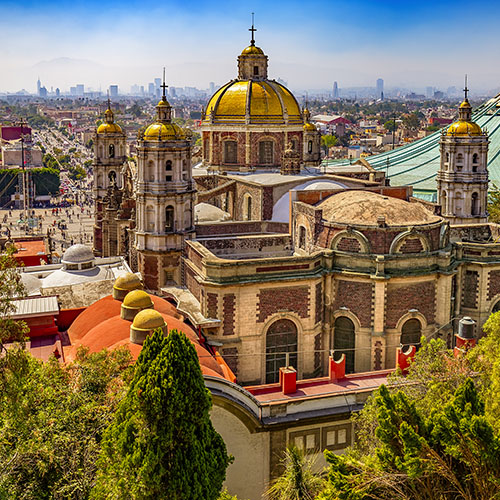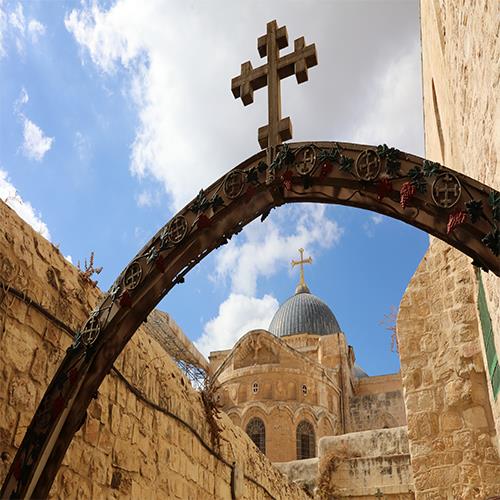Religion has been in the life presence of man for thousands of years. Some of the greatest houses of worship in the world date back to a time nearly that long ago. Still others are built as religions continue to amass devoted adherents, as today’s devoted wish to honor God (or gods!). Below you’ll find galleries of 60 noteworthy houses of worship from all over the world, and spotlights on important structures or cities and countries known for cathedrals, or churches, or temples, shrines, synagogues, mosques, and more!
Highlights from the Americas
Many immigrant societies in the Americas were first formed with religious freedom uppermost in mind. The United States is a top contender for the highest number of churches in the world, ranging from ornate cathedrals to modernist structures built into sides of cliffs. South America is even more enterprising, taking cathedrals to an opulent and novel level with the opening of Colombia’s church inside a salt mine. Below you’ll find notable churches, cathedrals, and more from all parts of the Americas. Take note: When exploring the following pages, keep in mind you can choose to tackle these locations on your own, or try using the Activities link where you may find guided tours!

Sedona, Arizona

Salt Lake City, Utah

Washington, D.C.

New York City

New York City

Montréal, Québec, Canada

Mexico City, Mexico

Metropolitan Cathedral

Castries, Saint Lucia

near Bogotá, Colombia


Lima, Peru


Buenos Aires, Argentina

Salta, Argentina

Zipaquirá, a city northeast of Bogotá, Colombia, is located in an area blessed with terrain made up of halite, or rock salt. As the city is built adjacent to a halite mountain, salt mining on the mountain has been lucrative here for hundreds of years. In 1932, miners carved out a sanctuary area so they could pray to Our Lady of the Rosary (patron saint of miners) before starting work each day. The idea of expanding the sanctuary into a full-blown church gained popularity with the miners, and in 1950, work began on the Salt Cathedral, which would be built 450 feet into the mountain. After four years, and a cost of $285 million (nearly $3 billion in today’s valuations), the Salt Cathedral opened as a symbol not only for Zipaquirá but to all of Colombia. To this day it is considered one of the best examples of homegrown Colombian architecture. In the 1990s, structural stability concerns caused the closure of the cathedral and the construction of a new, larger cathedral about 200 feet below the old one. It was opened to the public in 1995 and, at a very roomy 95,000 square feet (pictured), can accommodate as many as 3,000 worshippers each Sunday. The three-nave church includes chapels for each of the Stations of the Cross, plus columns representing the Four Evangelists and the sculpture La Creación del Hombre by Carlos Enrique Rodríguez (bottom of picture).
Highlights from Europe
Europe has been deemed a “living museum” where history, architecture, and religion intersect. Over 500,000 churches, cathedrals, synagogues, mosques, and more can be found in nearly every populated area on the continent. Which ones are the most special? We curated a list of 20 churches and cathedrals we think you’d find particularly interesting to pair with your next Tripmasters vacation! Remember, you can explore many of our suggestions independently, but use the Activities links where you may find expert-led tours which can enrich your understanding and appreciation for these unique places!


Liverpool, England

London, England

London, England

Mont-Saint-Michel, France

Paris, France


Fátima, Portugal


Seville, Spain

Barcelona, Spain

(Rome, Italy)

Florence, Italy


Milan, Italy

Cologne, Germany

Vienna, Austria

Budapest, Hungary

Kraków, Poland

Moscow, Russia

Rome has been a Christian pilgrimage site for hundreds of years. It is the final resting place of St. Peter, one of the founders of Christianity and one of its first martyrs. St. Peter’s Basilica (pictured) in Vatican City, west of the Tiber, houses the tomb where it is believed he was interred some time between 64 and 68 CE. You could spend days exploring the Vatican, seeing such sights as the aforementioned St. Peter’s, located on the western end of the square of the same name, where the pope is known to give special Masses to devoted crowds. (During the ongoing COVID-19 pandemic, various rules and safeguards are in place for your protection as well as the protection of those who live and work in the Vatican.) The Vatican Museums are located to the north of St. Peter’s Square, and include the Apostolic Library, the Pinacotheca, the Borgia Tower, and the Sistine Chapel. The Pope’s residence is just steps from the Sistine Chapel, and the Swiss Guards and the Papal Gendarmes are stationed just a few buildings away. At the southern end of the Vatican, there is a train station, which links to Roma San Pietro train station. When you get off the train, you can explore the Palace of the Tribunal, the Palace of the Governorate, the Pontifical Academy of Sciences, and beautiful gardens like the French, English, and American Gardens.
Mont-Saint-Michel is a small tidal island with a permanent population of just 30 people, located only 0.6 miles off the shores of Normandy in France. A key outpost situated at the mouth of the Couesnon River, it was strategically important to warring tribes as early as the fifth century CE. In the eighth century CE, a monastery and church were built, as it was believed by the Bishop of Avranches that the Archangel Michael came to him in a vision and told him to build a church there. Groundbreaking on the current abbey began in the tenth century, but it wasn’t completed until 1523. Part of the reason the abbey grew in size to necessitate the compound you see today is because of Mont-Saint-Michel’s existence as a tidal island. In low tide, the water dries out to such an extent that it was possible to walk from the Normandy beaches directly to the island. By the time of the French Revolution, the abbey was closed and it became a prison, the “Bastille of the Sea“. In the 19th century, it became a historic monument and a large-scale renovation took place. A small house of monks still live in the abbey today, returning in the 20th century for the first time since they were expelled in 1791. Mont-Saint-Michel (the island and the bay surrounding it) is listed by UNESCO as a World Heritage Site.

Highlights from Africa and the Middle East
Judeo-Christian religions saw the birth of their movements in the Middle East, in places like Jerusalem and Mecca. These religions have presences in nearly every country in the region, and Christianity and Islam in particular flourish in many African nations. Here are some of the most beautiful and historic temples, synagogues, mosques, and churches in Africa and the Middle East. Pro Tip: Use the Activities link from the following island/region pages to explore what tours may be available in each of these Unique Places.


Casablanca, Morocco


near Luxor, Egypt


Adana, Turkey

Jerusalem, Israel

Jerusalem, Israel


Abu Dhabi, United Arab Emirates

Jerusalem is a holy city for three major religions: Christianity, Judaism, and Islam. One of the most popular religious pilgrimage sites in Jerusalem’s Old City is the Western Wall, which has meaning to all three religions. For Muslims it is the place where Muhammad tied the winged creature Buraq while on his Night Journey to Jerusalem. For Jews it is used as a place of prayer, and the Western Wall of Temple Mount in particular is considered the most sacred site in Judaism because it is close to where the Holy of Holies was located, the sanctuary where God’s presence appeared to man. Christians pray at this wall also, although Christianity’s holiest site in the Old City is the Church of the Holy Sepulchre (pictured), where it is believed that Jesus Christ was crucified and was later resurrected. The Western Wall is so named because it is part of the retaining walls that encase the plaza at Temple Mount, venerated in all three religions but particularly meaningful to Jews and Muslims. Jews believe Solomon’s Temple was built here in the 10th century BCE, and Muslims believe the Dome of the Rock and Al-Aqsa Mosque to be amongst the holiest sites in Islam. Al-Aqsa Mosque was built on the site where Muslims believe Muhammad was deposited from Mecca while on his Night Journey.
Highlights from Asia
From Hinduism to Baha’ism, Shintoism and Buddhism, with Christianity, Islam, and other religions mixed in between, there is a very wide variety of religious buildings on display for tourists in Asia. Some date back hundreds and thousands of years, and others are new, elaborate, and ornate. Here are some recommendations we have when it comes to the most beautiful temples, shrines, and more on the Asian continent. Don’t forget, you can always choose to explore these beautiful sights on your own, but the Activities link found on the island/city pages can help you book a guided tour (where available)!







near Ninh Bình, Vietnam

near Kuala Lumpur, Malaysia


Java, Indonesia

Java, Indonesia





Japan is a society where two religions play large roles in everyday life. There is Buddhism, which most of east Asia also adheres to, but also homegrown Shintoism, which unlike Buddhism, embraces the idea of worshipping other deities. Shintoism requires its adherents to be one with nature, and doesn’t have much set “doctrine” the way Buddhism does. Between the two religions, there are nearly 200,000 temples (“temple“, such as Sensō-ji Temple in Tokyo, pictured, denotes Buddhism) and shrines (“shrine” denotes Shintoism) located across all of Japan’s 47 prefectures. Kinkaku-ji (The Temple of the Golden Pavilion) in Kyoto is one of the most legendary and popular Buddhist temples in Japan. The complex welcomes millions of tourists each year, and has been recognized as a National Historic Site and a UNESCO World Heritage Site. The original buildings dated from 1397, and the painstaking and flawless reproduction you see today is a result of a complete rebuild after a 1950 fire. Over 40 Shinto shrines have received the country’s highest conservation honor, that of “National Treasure“, including thirteen in the Osaka-Kyoto-Nara region as well as the UNESCO World Heritage Site Nikkō Tōshō-gū, located north of Tokyo. For more temple and shrine inspiration, visit our temples and shrines of Japan page on Tripmasters.
Thailand is a very Buddhist country: Over 97% of the kingdom’s 70 million people are adherents of Buddhism. The Southeast Asian nation is home to over 33,000 active Buddhist temples, making it a contender for the country with the most religious houses in the world. The most famous of the Thai temples has to be Wat Phra Kaew (pictured), located on the grounds of the Grand Palace in Bangkok. It is the home of the Emerald Buddha, one of Thailand’s most enduring national icons. The temple dates from the late eighteenth century and incorporates varied styles of Thai architecture. Other noteworthy temples in Thailand include Wat Rong Khun, the “White Temple” of Chiang Rai, which was built with white in mind because it is the color of “righteousness” and “good karma”. The temple features a bridge called “The Bridge of the Cycle of Rebirth“, built over a “sea” of hands meant to reach Earth all the way from hell. Additional well-known temples include the royal monastery, Wat Phra Si Samphet, in Ayutthaya; Wat Pho (Temple of the Reclining Buddha) and Wat Arun (The Temple of Dawn), among others, in Bangkok; and Wat Chalong in Phuket, among other places (like Sukhothai and Pattaya, already linked in the gallery).

For even more travel inspiration, be sure to check out a few more of our interest-driven curations by clicking on the pictures below.

Religious Pilgrimages

Holidays and Festivals

